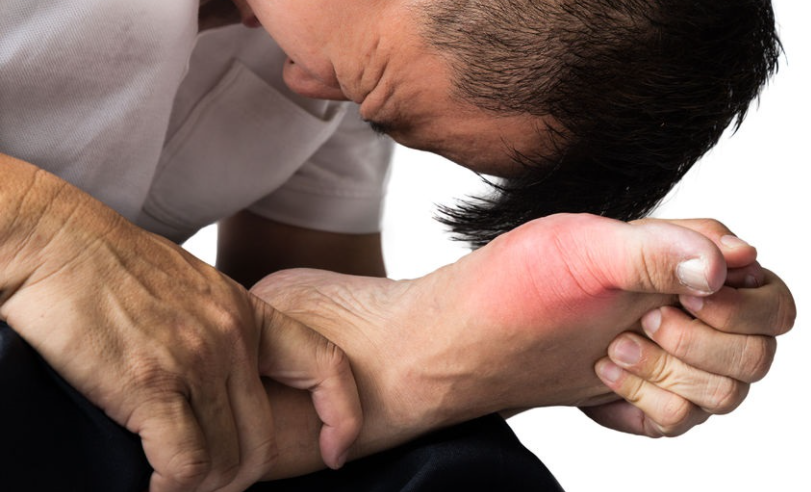
Gout treated by physiotherapy
Gout is a form of arthritis caused by a chronic condition called hyperuricemia, triggering pain and swelling in the joints. Hyperuricemia causes high levels of a substance called urate (AKA uric acid) in your blood and can form crystals that build up in different parts of the body.
In some people, the excess urate can manifest kidney stones and other problems with kidney function.
What causes gout?
Pain and inflammation develop when the white blood cells attempt to digest urate crystals that have shed from deposits to the fluid that lubricates the joints (called synovial fluid). These cells recognise the crystals as foreign material and release chemical signals that contribute to the pain, swelling, and redness associated with a gout flare.
How is gout diagnosed?
Gout is diagnosed using a combination of tests that are prescribed by your doctor. Potential tests include:
- Blood tests
- X-rays
- Testing of synovial fluid for uric acid crystals
- Examination of symptoms
Who is most likely to suffer from gout symptoms?
Gout is rare in childhood and usually develops in men earlier than it does in women. It is common for men to develop gout symptoms after the age of 30, whereas women over 55 are more at risk.
What are the symptoms of gout?
Gout can happen very quickly and there are a number of symptoms that can be experienced as a result of gout, depending on the type of flare-up and the history of your condition.
Potential symptoms include:
- Gout flares (also called gout attacks) are sudden episodes of severe joint pain, usually involving redness, swelling, and tenderness of the joint. This pain is often described as a burning pain. Gout flares start more often during the night and in the early morning hours than during the day, but they can occur at any time.
- Inflammation in certain joints, particularly the distal interphalangeal (DIP) and proximal interphalangeal joints (PIP) in the big toe, knee, elbow and wrist joints
- Redness and heat over the affected joints
- Tophi (pimples) under the skin from a collection of uric acid
- Stiffness, especially in the mornings or following a period of inactivity
- Extreme tiredness
What medical conditions and lifestyle factors can increase my risk of developing gout?
- Obesity
- High blood pressure
- Chronic kidney disease
- Consuming excessive amounts of alcohol
- Consuming large amounts of meat or seafood
- Consuming beverages containing high fructose corn syrup
- Taking medications that affect blood levels of urate
How can physiotherapy help with gout?
Expert physiotherapy can help you manage the symptoms of gout in a number of ways.
Often when a joint is in a flare-up of gout, walking can be extremely painful or nearly impossible. Your physio can advise you on when you should use a walking cane/stick to assist your gait. Walking without the proper support or with a limp for even a short period of time due to the pain of gout can cause you to develop incorrect gait patterns and put excess strain on the other joints of your body, particularly those in the lower extremities.
All exercises should be done between flare-ups rather than during a flare-up. Exercising a joint inflamed by gout is generally too painful, and may be detrimental to the joint due to the uric acid crystals that can wear on the joint surface during extreme motions of the joint.
Physiotherapy can also help by:
- Controlling your pain
- Helping you carry out your normal activities of daily living
- Reducing inflammation
- Reducing tiredness
- Improving your strength and range of movement
- Improving your cardiovascular fitness levels
Dietary changes — Improving your diet may reduce the frequency of gout flares. Because obesity is a risk factor for gout, as well as for many other health conditions, losing weight (if you are overweight) is an important goal.
Can hydrotherapy be helpful for treating gout?
During bouts of gout flare-ups, cold therapy is preferred over hot therapy, but in between flare-ups, hydrotherapy may be beneficial for causes of gout pain. Some clients will find that doing a exercise in the pool, along with their other stretching and strengthening exercises, is easier and less painful on their joints. As with other exercises, cardiovascular exercises are best done between bouts of gout rather than during a flare-up.
To book an appointment with one of our specialist physiotherapists, please call us on (02) 9428 5772 or send us an email at [email protected].



